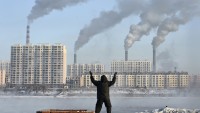Shocking NASA Images Show Aral Sea Completely Dried Up
| Kristina Fernandez | | Oct 01, 2014 05:00 AM EDT |
(Photo : NASA Earth Observatory via Reuters) NASA-released satellite images show how Aral Sea has dried up over the past 15 years. This images shows the Aral Sea (L) in 1989 and now (R).
Satellite imagery recently released by NASA showed the dramatic changes the Aral Sea has undergone in the past 15 years. What was once the world's fourth largest lake that straddles the Kazakhstan-Uzbekistan border has now become a vast wasteland.
The Aral Sea has been retreating for the last 50 years since the Soviet Union initiated in 1960s a massive irrigation project. The project diverted water coming from two rivers feeding the lake to irrigate cotton farms in the desert.
Like Us on Facebook
According to the report accompanying the NASA-released images, the Aral Sea has hit a new low in August of this year.
It is the first time in modern history that the eastern lobe of the South Aral sea has gone dry, Aral Sea expert Philip Micklin said. He added the last time this happened was 600 years ago.
Especially dry seasons in the last decades combined with the continuous diversion of water and the scarcity of snow in the mountains have accelerated the drying up of the lake that once supported a thriving fishing industry, NASA Earth Observatory reported.
The lake now only holds ten percent of its original water volume, Fox News reported.
The NASA satellite images show the shrinking of the lake since 2000, by which time Aral Sea was already a small fraction of what it was prior to the 1960s diversion. The images feature how the lake separated into northern and southern divisions, the latter further breaking up into eastern and western lobes while still being connected by a small channel of water at both ends.
In 2001, the connection disappeared while the eastern lobe began consistently disappearing in the subsequent years.
In a bid to save what remained of the lake, Kazakhstan built a dam in 2005 that connected the North and South Aral Seas, NASA Earth Observatory reported.
The irrigation program has devastated the lake, even while it helped sustain agriculture in the dessert.
This led to the collapse of the fishing communities that depended on the Aral Sea, and eventually polluting the soil with salty dust that settled on the lakebed. Now, "croplands had to be flushed with larger and larger volumes of river water," NASA reported.
TagsAral Sea, Aral sea completely dried up, Uzbekistan, Kazakhstan
©2015 Chinatopix All rights reserved. Do not reproduce without permission
EDITOR'S PICKS
-

Did the Trump administration just announce plans for a trade war with ‘hostile’ China and Russia?
-

US Senate passes Taiwan travel bill slammed by China
-

As Yan Sihong’s family grieves, here are other Chinese students who went missing abroad. Some have never been found
-

Beijing blasts Western critics who ‘smear China’ with the term sharp power
-

China Envoy Seeks to Defuse Tensions With U.S. as a Trade War Brews
-

Singapore's Deputy PM Provides Bitcoin Vote of Confidence Amid China's Blanket Bans
-

China warns investors over risks in overseas virtual currency trading
-

Chinese government most trustworthy: survey
-

Kashima Antlers On Course For Back-To-Back Titles
MOST POPULAR
LATEST NEWS
Zhou Yongkang: China's Former Security Chief Sentenced to Life in Prison

China's former Chief of the Ministry of Public Security, Zhou Yongkang, has been given a life sentence after he was found guilty of abusing his office, bribery and deliberately ... Full Article
TRENDING STORY

China Pork Prices Expected to Stabilize As The Supplies Recover

Elephone P9000 Smartphone is now on Sale on Amazon India

There's a Big Chance Cliffhangers Won't Still Be Resolved When Grey's Anatomy Season 13 Returns

Supreme Court Ruled on Samsung vs Apple Dispute for Patent Infringement

Microsoft Surface Pro 5 Rumors and Release Date: What is the Latest?












